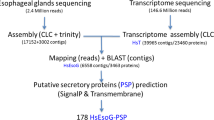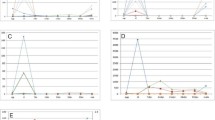Abstract
Identifying parasitism genes encoding proteins secreted from a plant-parasitic nematode’s esophageal gland cells and injected through its stylet into plant tissue is the key to understanding the molecular basis of nematode parasitism of plants. Parasitism genes have been cloned by directly microaspirating the cytoplasm from the esophageal gland cells of different parasitic stages of cyst or root-knot nematodes to provide mRNA to create a gland cell-specific cDNA library by long-distance reverse-transcriptase polymerase chain reaction. cDNA clones are sequenced and deduced protein sequences with a signal peptide for secretion are identified for high-throughput in situ hybridization to confirm gland-specific expression.
Access this chapter
Tax calculation will be finalised at checkout
Purchases are for personal use only
Similar content being viewed by others
References
Hussey, R. S. and Grundler, F. M. (1998) Nematode parasitism of plants, in Physiology and biochemistry of free-living and plant-parasitic nematodes, (Perry, R. N. and Wright J., eds.), CAB International, Wallingford, UK, pp. 213–243.
Mitchum, M. G., Hussey, R. S., Davis, E. L., and Baum, T.J. (2007) Application of biotechnology to understand pathogenesis of nematode plant pathogens, in Biotechnology & Plant Disease Management (Punja, Z. K., DeBoer, S., and Sanfacon, H. eds.) CAB International, Wallingford, UK, pp. 58–86.
Davis, E. L., Hussey, R. S., Mitchum, M. G., and Baum, T. J. (2008) Parasitism proteins in nematode-plant interactions. Curr. Opin. Plant Biol. 11, 360–366.
Wang, X. H., Allen, R., Ding, X. F., Goellner, M., Maier, T., de Boer, J. M., Baum, T. J., Hussey, R., and Davis, E. L. (2001) Signal peptide-selection of cDNA cloned directly from the esophageal gland cells of the soybean cyst nematode Heterodera glycines. Mol. Plant Microbe Interact. 14, 536–544.
Gao, B. L., Allen, R., Maier, T., Davis, E. L., Baum, T. J., and Hussey, R. S. (2001) Identification of putative parasitism genes expressed in the esophageal gland cells of the soybean cyst nematode Heterodera glycines. Mol. Plant Microbe Interact. 14, 1247–1254.
Gao, B. L., Allen, R., Maier, T., Davis, E. L., Baum, T. J., and Hussey, R. S. (2003) The parasitome of the phytonematode Heterodera glycines. Mol. Plant Microbe Interact. 16, 720–726.
Huang, G. Z., Gao, B. L., Maier, T., Allen, R., Davis, E. L., Baum, T. J., and Hussey, R. S. (2003) A profile of putative parasitism genes expressed in the esophageal gland cells of the root-knot nematode Meloidogyne incognita. Mol. Plant Microbe Interact. 16, 376–381.
Huang, G., Dong, R., Maier, T., Allen, R., Davis, E. L., Baum, T. J., and Hussey, R. S. (2004) Use of solid-phase subtractive hybridization for the identification of parasitism gene candidates from the root-knot nematode Meloidogyne incognita. Mol. Plant Pathol. 5, 217–222.
Hussey, R. S. and Barker, K. R. (1973) A comparison of methods of collecting inocula of Meloidogyne spp., including a new technique. Plant Dis. Rep. 57, 1025–1028.
De Boer, J. M., Yan, Y., Smant, G., Davis, E. L. and Baum, T. J. (1998) In-situ hybridization to messenger RNA in Heterodera glycines. J. Nematol. 30, 309–312.
Author information
Authors and Affiliations
Corresponding author
Editor information
Editors and Affiliations
Rights and permissions
Copyright information
© 2011 Springer Science+Business Media, LLC
About this protocol
Cite this protocol
Hussey, R.S., Huang, G., Allen, R. (2011). Microaspiration of Esophageal Gland Cells and cDNA Library Construction for Identifying Parasitism Genes of Plant-Parasitic Nematodes. In: McDowell, J. (eds) Plant Immunity. Methods in Molecular Biology, vol 712. Humana Press. https://doi.org/10.1007/978-1-61737-998-7_9
Download citation
DOI: https://doi.org/10.1007/978-1-61737-998-7_9
Published:
Publisher Name: Humana Press
Print ISBN: 978-1-61737-997-0
Online ISBN: 978-1-61737-998-7
eBook Packages: Springer Protocols




